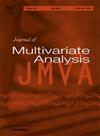统计有限元法的误差分析
IF 1.4
3区 数学
Q2 STATISTICS & PROBABILITY
引用次数: 0
摘要
最近提出的统计有限元(statFEM)方法将测量数据与有限元模型综合起来,并允许对未知的真实系统响应进行预测。假设噪声测量数据是由一个确定性真系统响应函数产生的,该真系统响应函数满足一个未知真源项的二阶椭圆偏微分方程,并基于高斯过程先验对一个典型的statFEM装置进行了概率误差分析。在某些情况下,高斯过程模型可能会错误地指定源项的平滑度等属性。我们得出的误差估计是关于真实系统响应与statFEM后验均值之差的l2范数的测量噪声的期望。这些估计意味着测量点和有限元基函数的数量的多项式收敛率,并取决于真源项和高斯过程模型的索博列夫平滑性。用泊松方程的一个数值例子来说明这些理论结果。本文章由计算机程序翻译,如有差异,请以英文原文为准。
Error analysis for a statistical finite element method
The recently proposed statistical finite element (statFEM) approach synthesises measurement data with finite element models and allows for making predictions about the unknown true system response. We provide a probabilistic error analysis for a prototypical statFEM setup based on a Gaussian process prior under the assumption that the noisy measurement data are generated by a deterministic true system response function that satisfies a second-order elliptic partial differential equation for an unknown true source term. In certain cases, properties such as the smoothness of the source term may be misspecified by the Gaussian process model. The error estimates we derive are for the expectation with respect to the measurement noise of the -norm of the difference between the true system response and the mean of the statFEM posterior. The estimates imply polynomial rates of convergence in the numbers of measurement points and finite element basis functions and depend on the Sobolev smoothness of the true source term and the Gaussian process model. A numerical example for Poisson’s equation is used to illustrate these theoretical results.
求助全文
通过发布文献求助,成功后即可免费获取论文全文。
去求助
来源期刊

Journal of Multivariate Analysis
数学-统计学与概率论
CiteScore
2.40
自引率
25.00%
发文量
108
审稿时长
74 days
期刊介绍:
Founded in 1971, the Journal of Multivariate Analysis (JMVA) is the central venue for the publication of new, relevant methodology and particularly innovative applications pertaining to the analysis and interpretation of multidimensional data.
The journal welcomes contributions to all aspects of multivariate data analysis and modeling, including cluster analysis, discriminant analysis, factor analysis, and multidimensional continuous or discrete distribution theory. Topics of current interest include, but are not limited to, inferential aspects of
Copula modeling
Functional data analysis
Graphical modeling
High-dimensional data analysis
Image analysis
Multivariate extreme-value theory
Sparse modeling
Spatial statistics.
 求助内容:
求助内容: 应助结果提醒方式:
应助结果提醒方式:


